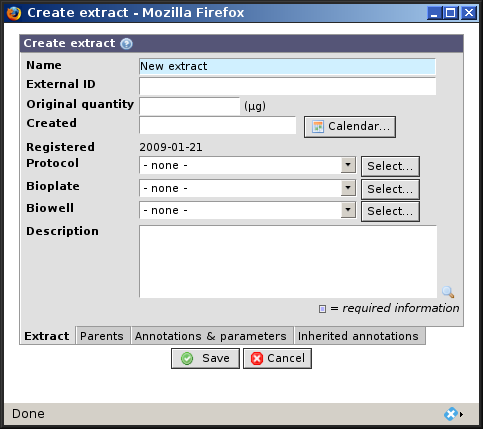Extract items should be used to describe the events that transform a sample material into an extract material. An extract can be created from one sample item or from one or more extract items. When an extract is created from several other extracts, a pooling event is performed.
During the transformation from samples to extracts, it is possible to provide information about the protocol used to perform this task. It is not enforced in BASE but it should serve as guidance when devising the granularity of the sample processing task. Also, it is good practice to provide protocol information.
Beside the common way, using the button, an extract can be created in one of the following ways:
- from either sample list- or single view- page.
-
No matter how complex the extract processing phase is, at least one extract has to be anchored to a sample. Therefore, a natural way to create an extract is to click on
 in the extracts column for the sample that should be a parent of the
extract.
in the extracts column for the sample that should be a parent of the
extract.
There is also a corresponding button, in the toolbar when viewing a single sample.
- from the extract list page
Pooled extract can also be created by first selecting the parents from the list of extracts and then press in the toolbar. The selected extracts will be put into the parent property.
- Name
A mandatory field for providing the extract name. BASE by default assigns names to extract (by suffixing
e#when creating an extract from an existing sample orNew extractotherwise) but it is possible to edit it at will.- External ID
The extracts identification outside BASE
- Original quantity
Holds information about the original mass of the created extract.
- Created
The date when the extract was created. The information can be important when running quality controls on data and account for potential confounding factor (e.g. day effect)
- Registered
This is automatically populated with a date at which the sample was entered in BASE system.
- Protocol
The extraction protocol that was used to produce the extract.
- Bioplate
The bioplate where this extract is located.
- Biowell
Biowell that holds this extract. Bioplate has to be defined before biowell can be selected.
- Description
A text field to report any information that not can be captured otherwise.
This important tab allows users to select the extract origin. BASE distinguished between two cases which are controlled by the Pooled radio-button.
If the parent is a sample the radio-button is set to No . The Sample select button is active and allows users to point to the sample from which the sample originates.
The parent is another extract and the radio-button is set to Yes . Upon selection, the samples select button is deactivated and the extracts box and button are activated. This allows users to specify one or more extracts to be selected from an extract list view page.
As seen in the biosource and sample sections, this tab allows users to supply further information about the extract, provided they have defined annotation types to annotation extract items or have such elements shared to them.
To learn more about annotation types, please refer to Chapter 11, Annotations
This tab contains a list of those annotations that are inherited from the extract parents. Information about working with inherited annotations can be found in Section 11.4.1, “Inheriting annotations from other items” .
